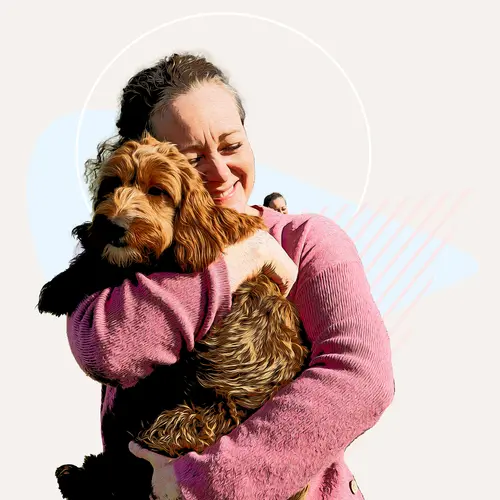Tracheal collapse in your dog is a serious disease of their trachea, windpipe, and lower airways. It worsens over time and can’t be reversed. It can be fatal if not treated. But with early diagnosis and proper treatment, your dog may have a good quality of life for years.
Your dog's trachea is a flexible tube with sturdy c-shaped rings of cartilage. These cartilages keep their trachea open for air to get in and out of their lungs. Tracheal collapse is a respiratory condition that occurs when the tracheal rings of cartilage collapse. As the windpipe collapses, it makes it hard for your dog to breathe and can cause a harsh, dry cough.
In most cases, the cause of tracheal collapse in dogs is unknown. But it’s a condition they’re born with (congenital). If your dog was born with it, their trachea may collapse due to not having enough cellular rings of cartilage.
If their trachea begins to collapse, you may hear a honking cough. This happens as the air pushes through the collapsing rings of cartilage.
How to Tell if Your Dog Has a Collapsed Trachea
Along with a honking cough, there are other signs of a tracheal collapse. Some of them include:
- Difficulty breathing
- Coughing when they're excited, you pick them up, or you apply pressure to their neck
- Vomiting, gagging, or retching associated with coughing
- Cyanotic (turning blue) episodes or bluish mucous membranes
- Wheezing
- Exercise intolerance
- Fainting
The cough caused by tracheal collapse is usually dry and does not come with a fever. It often worsens at night, when they're excited, during hot or humid weather, and immediately after they eat or drink.
What Are Risks for Tracheal Collapse in Dogs?
Small dog breeds are more at risk for this condition. They include:
- Pomeranians
- Miniature and Toy Poodles
- Yorkshire Terriers
- Chihuahuas
- Pugs
It's also most common in dogs who:
- Live with smokers
- Are middle-aged (but it can happen in younger dogs, too)
- Are overweight
Stages of Tracheal Collapse in Dogs
Tracheal collapse is classified into four grades:
- Grade 1: The tracheal lumen (a structure that supports your dog's trachea) is narrowed by about 25%, but the cartilage shape is still normal.
- Grade 2: The tracheal lumen is narrowed by about 50%, and the cartilage is partially flattened.
- Grade 3: The tracheal lumen is narrowed by about 75%, and the cartilage is nearly completely flat.
- Grade 4: The tracheal lumen is totally collapsed, and the cartilage is flat.
Consult with your vet if you notice any symptoms of tracheal collapse in your dog.
How Is a Collapsing Trachea Diagnosed?
Your vet will take a thorough history and do a physical exam to check what's happening with your dog. Based on their findings and what you tell them, they'll make a diagnosis and decide the best treatment.
They may do these tests on your dog before making a diagnosis:
Chest X-ray. This is used to rule out other conditions and discover whether the collapse is closer to the throat or within the chest.
Blood tests. This is used to look at your dog's overall health.
Endoscopy. This is where your veterinarian looks at the inside of your dog's trachea with a fiber optic camera.
Fluoroscopy. This is X-ray imaging that creates real-time moving images as your dog breathes.
Echocardiogram. This looks at your dog's heart function.
Treatment of Tracheal Collapse in Dogs
Most dogs with tracheal collapse can be treated with medications and preventive care, such as weight loss, using a harness for walks, and avoiding airway irritants. Once the vet makes a diagnosis, they may prescribe medication to manage coughing and inflammation.
Medical management
For mild to moderate cases, your vet may prescribe:
- Weight loss
- Antibiotics
- Cough suppressants
- Steroids (oral and inhalant, using an AeroDawg device)
- Bronchodilators
- Sedatives
Your vet may use sedatives to reduce your dog's coughing and anxiety. Some dogs may require heavy sedation to stop the cough cycle. Coughing only increases irritation, which then leads to more coughing.
Your vet may mention Maropitant (Cerenia®) as a drug of preference to lower inflammation in the airways.
Medical management works for a time in about 70% of dogs with tracheal collapse. But as the condition worsens, they may need surgery.
Surgical management
A vet surgeon may do surgery to place plastic rings on the outside of your dog's trachea to help protect and support it. Or they might place a stent inside your dog's airway to hold their trachea open.
If your dog has tracheal collapse, try to keep them away from airway irritants such as smoke and other fumes. Switching from a collar to a chest harness may help ease their coughing. It's important to see your veterinarian regularly and follow their directions.
Takeaways
Tracheal collapse is a serious and progressive disease in some dogs, especially small breeds. Being overweight or living with smokers increases their risk. Symptoms include a dry cough that sounds like a goose honking. Tracheal collapse can be fatal if not treated. But it's possible your dog could live years after diagnosis with proper veterinary care and treatment.
Tracheal Collapse in Dogs FAQs
How long can a dog live with a collapsing trachea?
There's no set time frame for how long they'll live. Proper management and care are key to quality of life.
Can tracheal collapse cause sudden death in dogs?
Yes, in severe cases.
What is end-stage tracheal collapse in dogs?
It's a severe condition where your dog has trouble breathing, persistent coughing, and a poor quality of life.
Is my dog's collapsed trachea worse at night?
Probably. Dogs with tracheal collapse often have a dry, persistent cough that gets worse at night, when they're excited, during hot or humid weather, and immediately after they eat or drink.



